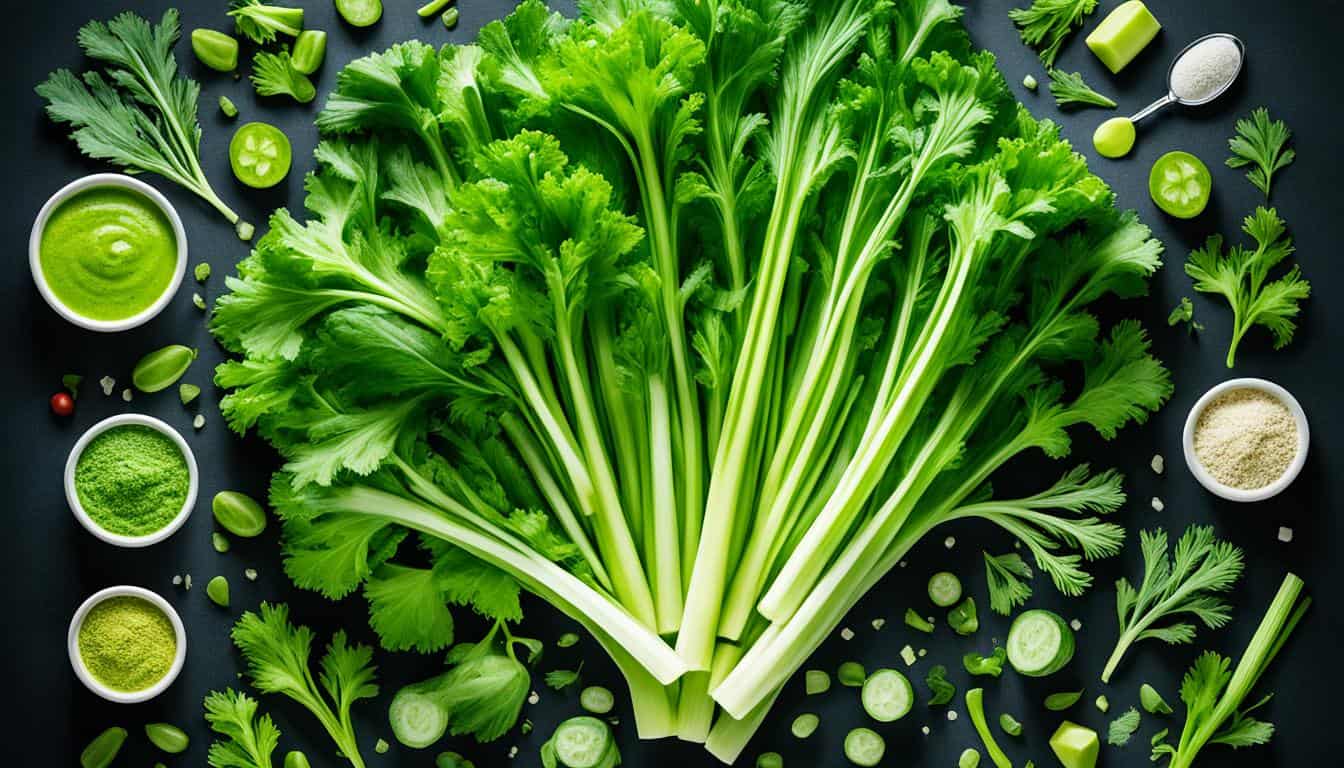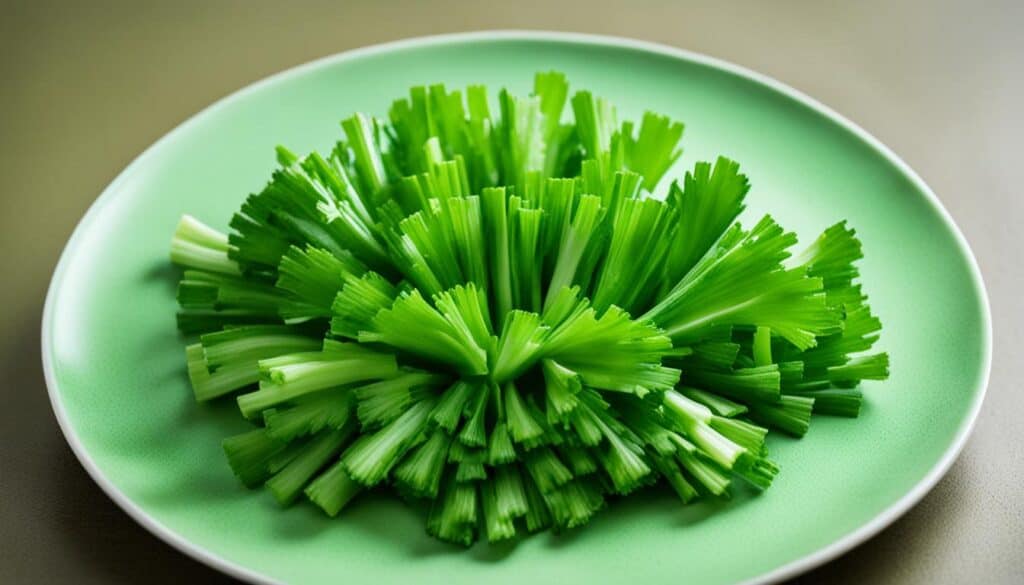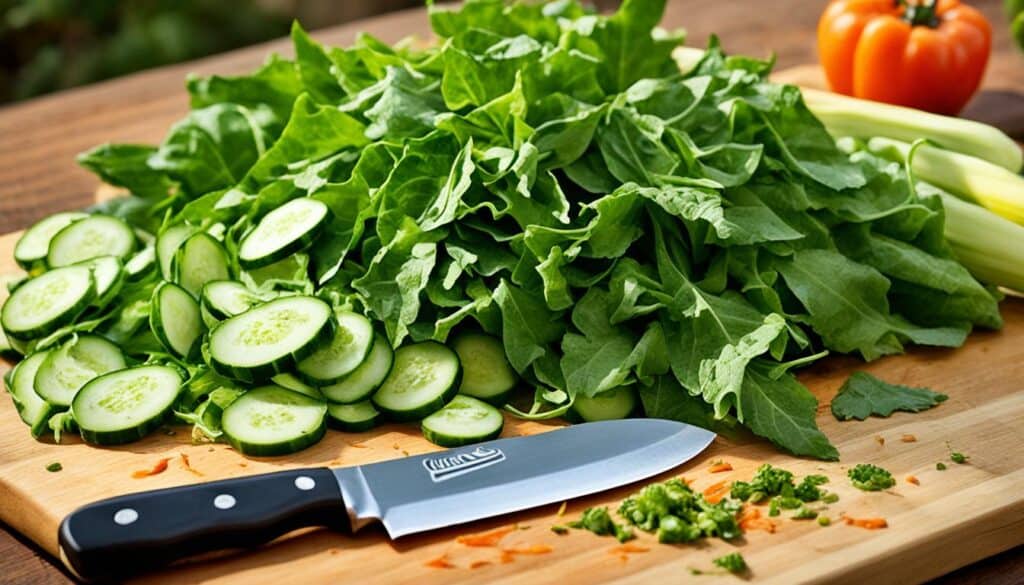Did you know that celery leaves, often overlooked and discarded, are actually a nutritional powerhouse? These organic celery leaves are packed with essential vitamins and minerals that can boost your health and add flavor to your meals. In this article, I will dive into the various benefits and uses of celery leaves, as well as provide some delicious recipes to try. So, let’s uncover the wonders of celery leaves!
Key Takeaways:
- Celery leaves are a superfood, rich in nutrients.
- They can be used in a variety of dishes to enhance flavor.
- Eating celery leaves can have numerous health benefits.
- Celery leaves are a versatile ingredient for both cooking and garnishing.
- Don’t discard celery leaves – put them to good use!
Types of Celery Leaves
When it comes to celery leaves, there is more than meets the eye. These versatile greens come in three distinct types, each with its own unique flavor and culinary applications.
The most common type of celery leaf is the flat celery leaf. This variety resembles parsley and can be used as a substitute in recipes that call for the herb. Its delicate and mild flavor adds a fresh and vibrant touch to salads, dressings, and sauces.
If you’re looking to add a robust and earthy flavor to your dishes, the serrated celery leaf is the choice for you. With a taste similar to celery root, this leaf is perfect for soups and stews, infusing them with a rich and aromatic essence.
For those who enjoy a visually striking presentation, the crinkled celery leaf is a go-to garnish. Its unique texture and shape make it an ideal choice for decorating plates and enhancing the overall aesthetic of your culinary creations. Additionally, it pairs well with bolder flavors, adding a hint of freshness to your favorite dishes.
Take a closer look at the different types of celery leaves:
| Type of Celery Leaf | Description | Best Uses |
|---|---|---|
| Flat Celery Leaf | Resembles parsley; delicate and mild flavor | Salads, dressings, sauces |
| Serrated Celery Leaf | Similar taste to celery root; robust and earthy flavor | Soups, stews |
| Crinkled Celery Leaf | Unique texture and shape; visually appealing | Garnish, plate decoration |
These three types of celery leaves open up a world of possibilities in the kitchen. Experiment with their flavors and textures to elevate your meals and delight your taste buds.
Nutrition of Celery Leaves
When it comes to nutritional value, celery leaves are a powerhouse. These leafy greens pack a punch in terms of essential nutrients, while still being low in calories. Incorporating celery leaves into your diet can provide a range of health benefits and boost your overall nutrition.
A cup of chopped celery leaves contains only 14 calories, making it an excellent choice for those watching their calorie intake. Despite its low calorie content, celery leaves are loaded with vitamins and minerals that are crucial for your body.
Here is a breakdown of the nutritional value of celery leaves:
| Nutrient | Amount |
|---|---|
| Vitamin C | 9.2 mg |
| Magnesium | 5.2 mg |
| Potassium | 74 mg |
| Fiber | 0.6 g |
As you can see, celery leaves are rich in vitamin C, which plays a vital role in supporting a healthy immune system and promoting collagen production. The magnesium and potassium found in celery leaves contribute to proper muscle function and maintaining a healthy blood pressure level. Additionally, the fiber content supports digestive health and helps you feel full for longer.
Adding celery leaves to your meals is a simple and delicious way to enhance the nutritional value of your diet. You can incorporate them into salads, soups, stir-fries, or use them as a garnish. Their versatility and nutrient density make them a fantastic addition to any meal.
Health Benefits of Celery Leaves
Eating celery leaves offers several health benefits. Let’s take a closer look at how they can improve your overall well-being:
1. Improved Digestion
Celery leaves contain a compound called apigenin, which can help improve digestion by stimulating the digestive system. This can aid in better nutrient absorption and prevent common digestive issues such as bloating and constipation.
2. Reduced Inflammation
The antioxidants present in celery leaves, including flavonoids and phenolic acids, have anti-inflammatory properties. Consuming celery leaves regularly can help reduce inflammation in the body, potentially alleviating symptoms of conditions like arthritis and inflammatory bowel disease.
3. Lower Blood Pressure
Celery leaves are a natural source of potassium, a mineral that plays a key role in regulating blood pressure. Including celery leaves in your diet can help maintain healthy blood pressure levels and reduce the risk of hypertension.
4. Reduced Cancer Risk
Studies have shown that celery leaves may possess cancer-fighting properties. They contain compounds like apigenin and luteolin, which have been found to inhibit the growth of cancer cells and reduce the risk of certain types of cancer, including breast and pancreatic cancer.
5. Aid in Weight Loss
Celery leaves are low in calories and high in fiber, making them an excellent choice for weight loss. The fiber content helps promote feelings of fullness and can support healthy digestion. Incorporating celery leaves into your meals can assist in weight management and maintaining a healthy body weight.
6. Help with Asthma Symptoms
The anti-inflammatory properties of celery leaves can also be beneficial for individuals with asthma. The antioxidants present in celery leaves may help reduce inflammation in the airways, potentially relieving symptoms like wheezing, coughing, and shortness of breath.
With such a wide range of health benefits, it’s clear that celery leaves are a valuable addition to a healthy diet. Their natural compounds and nutrients can improve digestion, reduce inflammation, lower blood pressure, potentially reduce the risk of cancer, aid in weight loss, and even help with asthma symptoms. So why not start incorporating more celery leaves into your meals today?
| Health Benefits of Celery Leaves | Description |
|---|---|
| Improved Digestion | Contains apigenin, which stimulates the digestive system. |
| Reduced Inflammation | Contains antioxidants that have anti-inflammatory properties. |
| Lower Blood Pressure | Natural source of potassium, which helps regulate blood pressure. |
| Reduced Cancer Risk | Contains compounds that inhibit the growth of cancer cells. |
| Aid in Weight Loss | Low in calories and high in fiber, promoting feelings of fullness. |
| Help with Asthma Symptoms | Anti-inflammatory properties may relieve asthma symptoms. |
Uses for Celery Leaves
Celery leaves are not just a garnish; they can be an essential ingredient in your dishes. Here are a few creative ways to use celery leaves in your cooking:
- Add them raw to salads: Celery leaves have a mild and refreshing flavor that pairs well with other salad greens. Chop them up and toss them into your favorite salad recipe to add a new layer of taste and texture.
- Use them as a sandwich topping: Instead of using lettuce or spinach, try placing a few celery leaves on your sandwiches. They will provide a subtle crunch and a hint of celery flavor.
- Enhance soups and stews: Celery leaves can be used as a garnish for soups and stews. Just sprinkle a handful of chopped leaves on top of your warm bowl of soup to add a fresh and herbal note.
- Experiment with cooked dishes: If you prefer cooked celery leaves, try steaming or sautéing them. They will retain their vibrant green color and add a delicate flavor to your stir-fries, pasta dishes, or vegetable medleys.
Celery leaves are versatile and can be incorporated into many different recipes. Don’t let them go to waste; use them to elevate your dishes and enjoy their unique taste.
| Dish | Uses for Celery Leaves |
|---|---|
| Salads | Add raw celery leaves for a refreshing twist. |
| Sandwiches | Use celery leaves as a crunchy and flavorful topping. |
| Soups and Stews | Sprinkle chopped celery leaves as a garnish. |
| Cooked Dishes | Steam or sauté celery leaves for added flavor. |
Recipe: Soup with Celery Leaves
Looking for a delicious way to enjoy the flavor and benefits of celery leaves? Try making a comforting soup that incorporates celery stalks, including the leaves. This flavorful and nutrient-rich soup is a great way to warm up on a chilly day. Let me walk you through the step-by-step instructions to create this delightful dish.
-
Ingredients:
- 4 celery stalks with leaves
- 1 onion, diced
- 2 cloves of garlic, minced
- 4 cups vegetable broth
- 1 tablespoon olive oil
- Salt and pepper to taste
-
Instructions:
- Start by washing and chopping the celery stalks, including the leaves.
- In a large pot, heat olive oil over medium heat.
- Add the diced onion and minced garlic. Sauté until the onions become translucent and fragrant.
- Next, add the chopped celery stalks and leaves to the pot. Sauté for a few minutes to enhance their flavors.
- Pour in the vegetable broth, and bring the soup to a boil.
- Reduce the heat to low, cover the pot, and simmer for about 20 minutes or until the celery stalks are tender.
- Once the soup is ready, use an immersion blender or a regular blender to puree the mixture until smooth and creamy.
- Taste the soup and season with salt and pepper according to your preference.
- Serve the soup hot, garnished with some fresh celery leaves for an extra burst of flavor.
This celery leaf soup is a delicious and nutritious way to incorporate celery leaves into your diet. The combination of celery, onions, and garlic creates a rich and satisfying flavor, while the smooth texture of the soup makes it a comforting meal option. Enjoy it as a starter or pair it with a fresh salad for a wholesome and satisfying lunch or dinner.
Try this recipe the next time you have celery stalks with leaves on hand, and explore the wonderful flavors that celery leaves bring to the table.
What to Do with Celery Greens to Make Them Taste Good
If you’re wondering how to make celery greens taste good, there are several ways to do so. You can sauté them in olive oil and garlic, roast them with seasonings, chop them up and add them to various dishes like stir-fries or pasta, or even use them as a base for a soup or stew. These techniques will enhance the flavor of celery greens and make them a delicious addition to your meals.
“Sautéing celery greens in olive oil and garlic adds depth of flavor and a touch of sweetness to the greens. You can also try roasting them, which enhances their earthy notes and brings out a delightful crunch.”
Another way to enjoy celery greens is by chopping them up and adding them to stir-fries, pasta dishes, or even salads. They provide a refreshing and slightly tangy taste that complements a variety of flavors. Additionally, using celery greens as a base for a soup or stew can infuse the dish with a subtle celery flavor and boost its nutritional value.
Try this Delicious Recipe with Celery Greens:
Celery Greens Stir-Fry:
- Heat some olive oil in a pan and add minced garlic and chopped celery greens.
- Sauté the mixture until the greens are slightly wilted, but still retain their vibrant color.
- Add your choice of protein or vegetables, such as tofu, mushrooms, or bell peppers.
- Season with soy sauce, sesame oil, and a squeeze of fresh lemon juice.
- Stir-fry until everything is well-coated and heated through.
- Serve hot and enjoy the delicious flavors of celery greens!
With these simple tips and recipes, you can transform celery greens into a culinary delight. Whether sautéed, roasted, or incorporated into various dishes, celery greens add a fresh and vibrant touch to your meals. So don’t let those greens go to waste – savor their deliciousness and reap the nutritional benefits they have to offer!
Substitute for Celery Leaves
If you don’t have celery leaves on hand or want to try something different, there are some substitutes you can use. Fresh parsley or cilantro can be used as a substitute for flat celery leaves, while celery root or celery seeds can be used as a substitute for serrated celery leaves. These alternatives can provide a similar flavor and texture to your dishes.
Substitutes for Flat Celery Leaves
If you’re looking for a substitute for flat celery leaves, fresh parsley or cilantro can work well. These herbs offer a similar herbaceous flavor and can add a vibrant touch to your dishes. Whether you sprinkle them over salads, incorporate them into sauces, or use them as a garnish, parsley or cilantro can provide a delightful alternative to celery leaves.
Substitutes for Serrated Celery Leaves
When it comes to serrated celery leaves, celery root or celery seeds can be great substitutes. Celery root, also known as celeriac, has a similar earthy flavor to celery leaves and can be used in soups, stews, or roasted dishes. On the other hand, celery seeds can add a distinct celery-like flavor to your recipes. They can be ground and sprinkled over salads, used as a seasoning in cooking, or even infused in oils or vinegar for added depth of flavor.
Experimenting with these substitutes can expand your culinary horizons and add a unique twist to your dishes when celery leaves are not available.
Substitutes for Celery Leaves
| Substitute | Usage | Flavor Profile |
|---|---|---|
| Fresh Parsley | Salads, sauces, garnish | Herbaceous, vibrant |
| Cilantro | Salads, sauces, garnish | Herbaceous, fresh |
| Celery Root | Soups, stews, roasted dishes | Earthy, savory |
| Celery Seeds | Salads, cooking, infusions | Celery-like, aromatic |
Explore these substitutes and let your creativity soar in the kitchen. Whether you’re using fresh parsley, cilantro, celery root, or celery seeds, you can still enjoy the flavors and versatility offered by celery leaves. So don’t hesitate to try these alternatives and discover new dimensions of taste in your favorite recipes.
Conclusion
In conclusion, celery leaves are not just a mere afterthought when using celery in your recipes – they are a powerhouse of flavor and nutrition. Whether you choose to incorporate them raw into your salads, use them as a garnish, or cook with them, celery leaves can transform your dishes into something truly special.
Not only do celery leaves add a refreshing touch to your meals, but they also offer a range of health benefits. Their ability to improve digestion, reduce inflammation, and aid in weight loss makes them a valuable addition to any healthy diet. Don’t let those vibrant green leaves go to waste – embrace their wonders and make the most of their incredible potential.
So the next time you grab a bunch of celery from the grocery store, remember to hold on to those celery leaves. Explore their culinary possibilities, experiment with different recipes, and enjoy the fresh taste and nutritional benefits they bring to your table. Celery leaves are a true gem waiting to be discovered – so go ahead and unleash their magic in your kitchen!










Leave a Reply